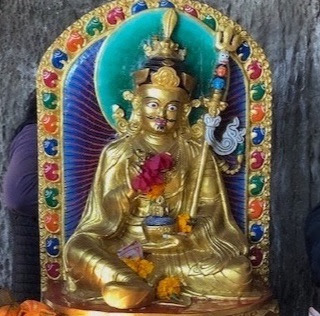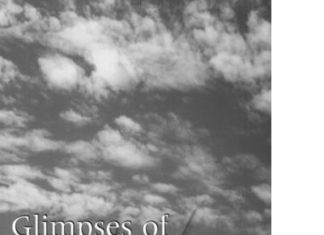
Sacred Outlook / Pure Perception (dak-nang in Tibetan) is the main cornerstone of Vajrayana. Without it there is no Vajrayana. Sacred Outlook is the modus operandi of the Kathmandu Valley. Without it there is no Nepal.
When Tibetans were forced into exile by the Chinese Communist invasion of Tibet, two of the most prominent places of refuge were Kathmandu, Nepal and Dharmsala, India. Within Kathmandu, the village of Boudha, the site of the Great Stupa of Boudhanath, became an un-wobbling pivot around which Tibetans gathered to live, to work, and to revere. Monasteries and temples of all schools of Tibetan Buddhism have sprung up around the Stupa. Circumambulation of the stupa is a given activity of everyday life. When the Tibetan diaspora arrived, it was a leap back into grandmother’s lap. It was a return to the source.
When the world and events spin out of control or are severally challenged, it is wise to return to the source. This is true of places, but all the more so for spiritual practice and culture. One could even coin a slogan, “When the world is full of chaos, return to the source.” It could be coming back to the breath in meditation, coming back to one’s most basic sanity as a person, or coming back to a place.
The Tibetans integrated into Nepali society in a country whose king at the time had generously opened the doors of the country to a population in dire circumstances. Unlike some returns to sources, the Tibetans integrated well into the existing multi-cultural fabric of Nepali society. Just in Boudha, there are at least 32 ethnicities living. The Tibetans were the guests. Yet this place and this stupa in Boudha is their roots. They have, with all the other ethnicities in Boudha, now become the hosts.
The story of the Great Stupa of Boudhanath is well-documented both in Nepali annals, in Tibetan pilgrimage guides and in revealed treasures, terma. The story goes that a simple lower caste poultry raiser gained financial success in her business enough to make a very pure aspiration. She aspired to build a large stupa. But she needed to petition the king to grant use of the land for her vision. The king, impressed with the financial success, determination, and purity of intent of this women, granted the permission. The woman, Jadzima, had three sons, and all went to work on building the stupa. As progress on the construction made the scale of the stupa more apparent, prominent local people became alarmed, and pleaded with the king to cancel the project, as it was making them lose face, being overshadowed by a low caste poultry woman. But the king responded that the integrity of his word would be honored, saying “The king speaks only once!” And so the name of the stupa is that very proclamation by the king, Jarung Kashor.
Jadzima, the poultry woman, then made a very pure and sincere dedication of the merit from building the stupa, which was that by that merit the Buddha Dharma would be established in the snowy lands of the north, Tibet. Consequently, her three sons were reborn in their next lives as King Trisong Detsen of Tibet, the great scholar-practitioner Santarahshita who brought the Buddhist teachings into Tibet, and Padmasambhava / Guru Rinpoche, the great Tantric master who tamed the Tibetan landscape and all its deities and drove the stake of Vajrayana deep into Tibetan soil. This, then, was the wellspring of Tibetan Buddhism and its enduring culture. It traces back exactly to the pure aspiration of Jadzima and the Great Stupa of Boudhanath, the source. It was natural, then, that Tibetans returned to this source, though regretfully as a result of being refugees from a genocidal attack on their homeland.

Photo by Clarke Warren
At one juncture of the stupa, there is a chapel and shrine to Jadzima. It is continually accessed to make offering, supplicate, and reconnect. On feast days, the ancestral keepers of the stupa perform feast offering sadhanas with full regalia and orchestration. Just today, the chapel is alive with the vibrant chanting and bell ringing of a feast offering. Jadzima is still very much alive.
At the 1980 Vajradhatu Seminary, the three-month study and practice retreat which was the gateway of Chogyam Trungpa Rinpoche’s students into Vajrayana practice, Bob (Mipham) Halpern and I were co-teaching a course called History and Devotion. We had an interview with Trungpa Rinpoche to discuss the trajectory of the course, and we asked “What DOES history have to do with devotion?” He answered succinctly, “History IS devotion.” During that course and still today, I regard that statement as somewhat of a koan. So much of history seems all but devotion, unless it is devotion to suffering. But having lived in the Kathmandu Valley for nine years and still returning here whenever I can, the meaning of that statement has become clearer and clearer. There is samsaric history and there is sacred history. They are not necessarily separate, but beneath the samsaric history there is what Lowell Thomas, the intrepid early news broadcaster said at the end of his broadcasts…
“…and that’s the other side of the story.”
Many, I suspect most, Westerners who visit Kathmandu stay briefly because they have to land here at the airport, then, after perhaps a brief tourist-oriented tour, if that, run off to trekking in the Himalaya, to escape the chaotic traffic, the choking pollution, and the less-than-ideal hygienic conditions in Kathmandu. (And join in the traffic jams of international trekkers along the hiking routes these days!) Those who stay on longer are perhaps working for NGO’s or embassies, students & teachers, researchers, Jesuits and other missionaries, anthropologists, etc. There is also a stratum of people who stay on who have forged a deep and enduring connection with the Valley and the people of Nepal. Generically called expats, they have stayed on for years, dealing with the enduring challenge of visas in whatever way it takes and putting down roots, figuring out how to stay healthy, forging enduring friendships with locals, and continually discovering deeper and deeper layers of the culture and energy here. Of course the most famous group heralds back to the 1960’s and early 1970’s, when Kathmandu was a major world destination for hippies (who were at one point summarily expelled from the country by the royal government to clean things up before a coronation). And then there were the spiritual seekers…both the itinerant Hindu-oriented ones as well as the earlier and later explorers of Tibetan Buddhism. (A highly entertaining characterization of this era and phenomena and a great read is in the book Karma Kola by Gita Mehta.)
Having lived in Boudha for the years I did, I have consulted with many others who, like myself, forged an adamantine connection with the Kathmandu Valley. We all agree there is a deep pulse to the Valley, one that resounds from antiquity but is daily palpable and accessible in the culture and the place, despite, or even perhaps because of the charnel ground realities of contemporary life here. (Boudha is, in fact, one of the Eight Great Charnel Grounds of Tantric lore.) The Valley is a web of thousands of stupas, temples, statues, shrines, and even simple trees and stones with spiritual significance. If one is blindfolded and turned loose, one would likely trip over a sacred object within a short time of wandering. The culture resolves around these vital points of tradition and daily life.
Although the Valley has undergone layers of unfortunate consequences from alleged modernization…traffic, over population, pollution, lack of well-managed utilities and hygiene, on and on…as well as more traditional forms of degradation…corruption, caste discrimination, dismal treatment of widows, on and on…still the pulse continues. Of course despite being a sacred realm (“Nepal Mandala” by its own designation), Nepal has always been a member in good standing of Samsara, no one can caste it as an ideal enlightened realm. Yet powerful enlightened activities have accompanied its history, like awakened dolphins swimming in tandem with the great ship of its course through time. And at times actually piloting that ship. As someone once said, “Society is basically good!”
Tibetan Buddhism came from Nepal and from India. (I once asked Samten Nagarjan, an early student of Chogyam Trungpa, “Where did Tantra come from? You should know, you are Indian”. He shot back, “The jungle of course!”) The sadhanas and songs intoned here in Sanskrit are the last vestiges of how Dharma sounded like and was practiced in India before Buddhism was wiped from the Indian landscape by invading Islamic armies. Nepal escaped all but one brief Islamic attack, and is therefore a time capsule of original Indian Subcontinent Buddhism. And in addition, the great lineages of Tibetan Buddhism connect back to the Kathmandu Valley like computers connecting to the worldwide web.
When I first came here, I was only interested in Tibetan Buddhism. After all, I was living in the same neighborhood as the vajra family of my root teacher, Chogyam Trungpa Rinpoche. Right up the street or nearby were Thrangu Rinpoche, Tulku Ugyen, Rabjam, Rinpoche (and before me being here, Dilgo Khyentse Rinpoche), Chobgye Trichen Rinpoche, Tenga Rinpoche and many more. I had to schedule carefully in order not to be enticed into too many dharma activities and teachings, plus my work (directing a study abroad program) was consuming. But as I stayed longer, the underbelly of Vajrayana became more and more prominent…the Newar Buddhism (Newars are the original people of the Kathmandu Valley) roots of not just Vajrayana, but dating back to the Buddha, and all three historical developments of Theravada, Mahayana, and Vajrayana. In fact, Newar Buddhism of the Kathmandu Vally traces it roots to a Buddha before Shakyamuni…Dipankara. And one of the main family/tribal descents of the Newars, the Sakyas, claim descent from Gautama Buddha’s family.
Nepal is where the Buddha was born. King Ashoka came here, and helped build the sacred city of Paten, establishing four stupas in the four directions of the city, each containing remains of Shakyamuni Buddha. His daughter Charumati likewise embellished the sacred Valley. Vasubandu died and is interned in a stupa here. There is a cave where Nagarjuna stayed in retreat. Atisha sojourned here on his way to Tibet. Yeshe Tsogyal came here and met her destined Nepali consort (Padmasambhava was probably ok with it!) Mahasiddhas adorned the spiritual and physical landscape. There are adjoining caves on the Basmati River where Tilopa and Naropa lived and practiced. The mahasiddha Phamtigpa, a vajra brother and fellow student of Naropa with Marpa, had a direct vision of Vajrayogini and built a Vajrayogini temple on the site of his vision. His direct descendants still maintain the temple, and I had my picture taken with the one who is the temple priest two days ago. As the faces of women holding their men pass by on the backs of motorcycles, it is clear where Vajrayogini’s iconic face originated from. Buddha, Avalokiteshvara, Tara, Chakrasamvara, Vajrayogini, Mahakala, and representatives of all the three roots have their residences here, and are implored into daily life on a daily basis.
In sacred history, the entire Valley itself was a great lake drained by Manjushri to make accessible to humans a lotus of enlightened energy that sat in the middle of the lake. Manjushri then proceeded to create the societal structure, the education, the laws and the sacred world of the Kathmandu Valley…he created Newar civilization.
If this sacred realm were to be placed in the lineage trees of Vajrayana Buddhism holding all the lineage holders, it would, and IS, the tree itself. History here is not a chronicle of events elapsed, but one swims in history every day. Indeed here in Kathmandu, history IS devotion.
Next time: Local haunts where Marpa hung out, and the Four Vajrayogini Sisters.
Clarke Warren
Boudha, Kathmandu, Nepal
November 19, 2023

















